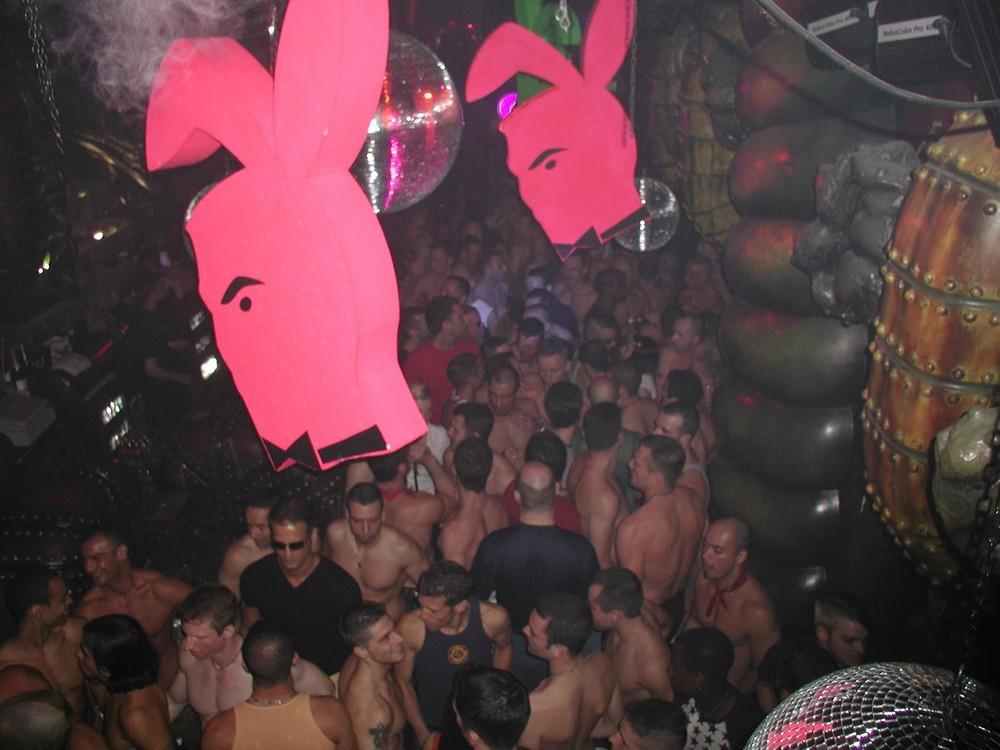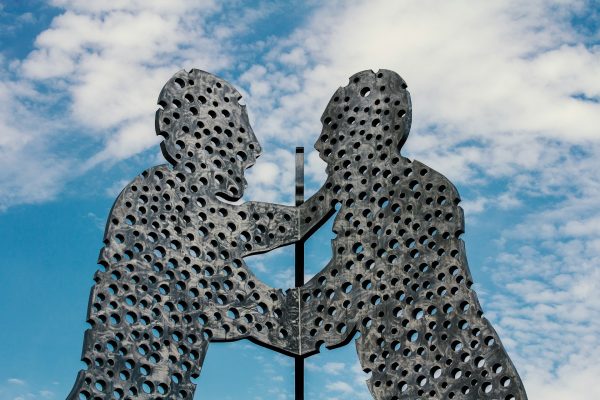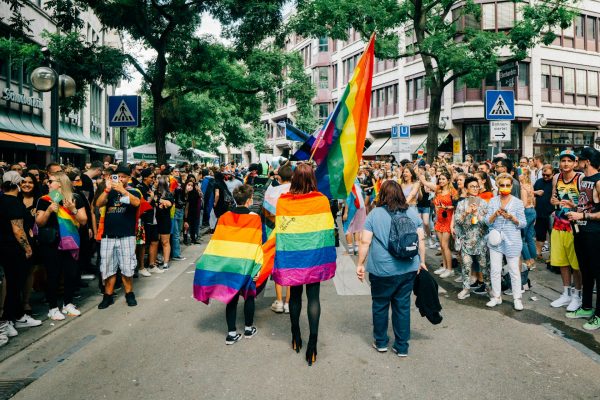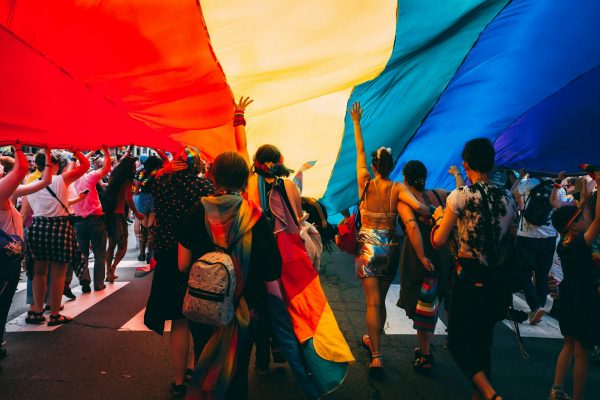I remember the first time I went to the now legendary queer night Sink the Pink; it was like a fabulous dream. The Bethnal Green Working Men’s club had been transformed into a raging, disco-ball-lit wonderland, a complete departure from the dingy and (very occasionally) neon-lit basement clubs I was used to frequenting. Eschewing the shirt and jeans I had worn to the club in favor of a man’s leather top I found on the floor (years later I still wear it as a dress when I want to look extra slutty, even if it fits me so badly that really it looks like I’m wearing a zipped up bin bag) I hooked up with my dream crush beneath a canopy of sweaty feathers. I saw several of my friends in full drag for the first (but certainly not the last) time. I knew all the words to all of the songs.
One of the reasons that night felt like such a revelation was the riot of campness and color in the décor, in the outfits, in the music. I’d spent the last four New Years Eve’s dancing in warehouses to UK garage, after spending my adolescence in the often strangely monochrome cultural interim of the Camden indie scene. Being gay was pretty ok (at least in theory), but queerness wasn’t really on the agenda, and the camp was decidedly naff.
But for those who want their club-nights screamingly kitsch and covered in glitter, the last few years has provided a fresh crop of camp. From the now mighty brand that is Sink the Pink to Bethnal Green’s Girls to the Front and Unskinny Bop, to the soon to be launched queer live music night Camposphere, the pickings are increasingly rich.
Of course, camp has always been part of the look and sound of gay nightlife, but its current incarnation seems to be both a nostalgic gesture towards the diamond-edged, Spice Girls brash of the nineties and at the same time a reinvention: camp representing a sloppier, psychedelic and above all less binary incarnation of the queer scene. Amy Redmond, one of the founders of Sink the Pink, says that one of her and (co-founder) Glyn Fussel’s reasons for setting up the night was ‘…that when we moved to London and went out to some gay bars… we didn’t feel particularly welcome or at ease: Glyn wanted to snog boys, and so did I, and we had to go to different venues to make that happen, which kind of felt ridiculous! We wanted to put on a party where we could both snog boys!’ She adds ‘What a selfish reason to start a club night!’ but the thrust of the statement is important- the New Camp attempts to locate a variety of genders and orientations within a tradition which used to principally celebrate gay men.
How and why this is happening now is difficult to establish, because although camp itself is militantly superficial, its symbolism and its effect are complicated and controversial. Something worth considering about this New ‘Queer’ Camp is that it provides a much-needed kick back to the rise of normcore style, a tribe which explicitly rewards uniformity, and less explicitly places an emphasis on conventional standards of beauty and body type. It is fair to point out that normcore also embraces androgyny and in that way presents a reaction to gender binaries. However, the way I read this reaction is as an erasure of difference which really serves the unchanged agendas of the fashion industry (everyone gets thin, everyone spends money). It’s interesting to consider that the 90’s brit-camp that the New Queer Camp recalls also emerged from an androgynous anti-fashion landscape of grunge, where men and women alike were dressed in baggy ripped jeans and shapeless sweaters. Perhaps one of the things that separate the gender- agenda of camp style from the move-towards-the-middle of grunge and normcore is that the latter has everyone wearing the same stuff, whereas camp argues loudly and brashly that anything goes- you can be a man in a wig or a woman with a mustache and nobody gives a shit. It’s no wonder that this embrace of the spectrum and all its extremes will inevitably pop up in response to fashion moments that aim to aesthetically represent a shrug, whether the noncommittal (grunge) or the Gallic (normcore).
Camp has always been political- it’s just that sometimes it puts on a show of having forgotten as much. Sink the pink, Amy Redmond explained, “was never created as a reaction to gender identity or with any political statement, it was created as a space to be as silly as possible with all of our friends.” But it’s in this silliness that the politics is to be found. The political importance of nights like Sink the Pink rests on saying ‘fuck it’ to supposedly ‘deep’ political categories and ideas and thereby eliminating them. Describing the radical potential of camp the founders of Camposphere urged that “In focusing its attention on the surface camp isn’t ignoring the deeper reality, it denies the idea of a deeper reality. Social truths are worn on the exterior; they exist only in clothes and outward signs, they’re (literally) fabricated. Campness reminds us of that. We live on the surface, in the glitz and the glamour. There is no deeper reality. We used to know that when the Spice Girls were the UK’s biggest pop stars. Now that we have Zayn Malik we think the world needs reminding.”
So much of camp, and particularly the kind of camp embodied in drag, is a political commentary on and reaction to mainstream popular culture. One sign of camp’s power, however, is its ability to subvert and rebrand the mainstream figures it comments on to suit its own ends. It’s no easy task to appropriate someone like Britney Spears- a straight woman from conservative Mississippi- into queer culture. You don’t do it by throwing a handful of glitter in her face and crossing your fingers[1]. I don’t doubt that camp could yet take on Zayn Malik and win.
But as a reaction to mainstream (read: straight) nightlife, how effectively does New Camp function? Amy Redmond observes that ‘There’s something about reclaiming a space and queering it… maybe particularly a very hetero space, that we find really empowering and celebratory.’ Of course, nothing does ‘celebratory’ like the hysterical sparkle of camp. Its disregard for subtlety in look and sound makes it very efficient at ‘queering a space.’ But if you queer a space with a happy group of likeminded party animals, off their tits and dressed as unicorns, does it stay queered? Considering the wave of recent shutdowns of iconic gay venues, in London and elsewhere, perhaps not. Even the gay clubs which continue to thrive often do so by assimilating straight crowds- consider the Dalston strip, which is now heavily patronized by the straight clubber overflow from Shoreditch.
Of course, inclusivity can be a force for good, but not if it comes at the expense of the culture it envelopes. There are plenty of gay bars and clubs in East London which are now queer only in name, unable to maintain their status as safe, loving spaces for LGBTQIA+ people in the face of… well, an overwhelming wave of cisgendered straight people. You only have to look at the trembling face of a drag queen singing a heartbreak ballad to understand that camp isn’t shatterproof- that’s part of its charm.
The superficiality that makes camp political also makes it vulnerable to being underestimated and overpowered by outside forces. New Camp has something vital to say. So go to the nights that embody its spirit, get obliterated, get dancing, get with whoever you want, but don’t get complacent. Camp probably isn’t going anywhere, but whatever incarnation it presents itself within, we must hold on tight to its message, or run the risk of losing it.
[1] Although obviously, this is a crucial part of the process.






